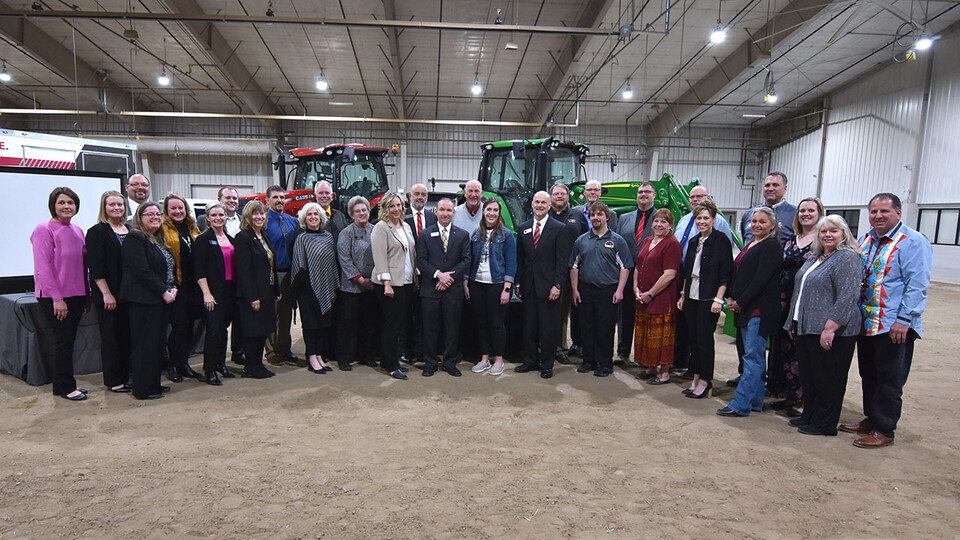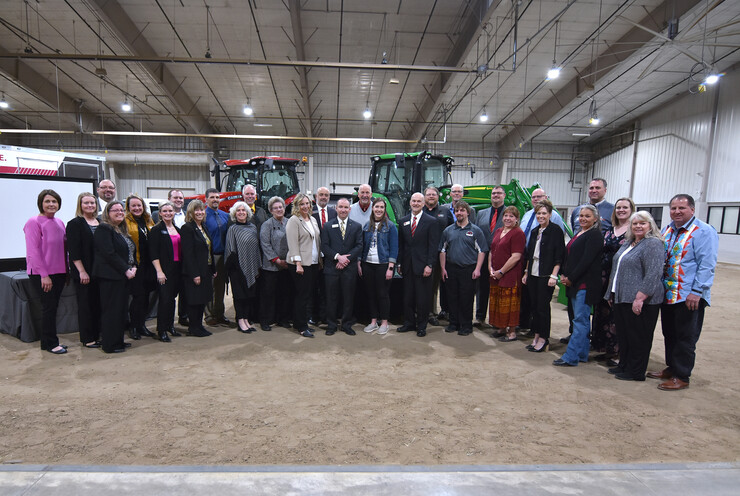· 6 min read
Educator input to provide guidance as northeast Nebraska compact expands

The Northeast Nebraska Agriculture and Natural Resources Education Compact, a first-of-its-kind regional education partnership launched in 2019, expanded its membership at a March 29 signing event, adding 20 school districts and three Educational Service Units in the state’s northeast region.
That expansion extended the compact’s reach as far west as Ainsworth and includes all of northeast Nebraska’s tribal schools. The University of Nebraska–Lincoln’s College of Agricultural Sciences and Natural Resources was one of the founding member organizations, which aim to enhance K-12 instruction via partnerships and facilitate collaboration among higher-education institutions to expand opportunities for students.
A survey now underway among K-12 educators in northeast Nebraska will provide key input in shaping the compact’s priorities and direction, said CASNR Dean Tiffany Heng-Moss.
“Anytime that we are trying to develop a new program or trying to serve the K-12 system, you have to first listen,” she said. “You need to listen to what are the needs, what are the gaps, what are the opportunities.”
This initiative, she said, is “really going to be designed around the input from the K-12 partners.”
Increased use of expertise and facilities at Nebraska’s Institute of Agriculture and Natural Resources will serve as an important resource for students and teachers. Another priority is strengthening schools’ interaction with industry to help students understand the breadth of careers in agriculture and natural resources.
Member organizations will provide supports not only to college-bound students, but to all students in the compact region, said Tammy Mittelstet, CASNR’s statewide education and career pathways coordinator.
“We want all students to be successful,” she said. “We want all students to find a clear education pathway” through coordination among the compact’s educational institutions. “So we’re looking at every child, not just the ones who might come to the university, because our land-grant mission is for all Nebraskans.”
The compact’s original partner organizations were CASNR, Little Priest Tribal College, Nebraska College of Technical Agriculture, Nebraska Indian Community College, Northeast Community College, Wayne Community Schools and Wayne State College.
At the March 29 signing event at Northeast Community College, ESUs 1, 7 and 8 joined the compact, along with the following school districts: Ainsworth, Allen, Battle Creek, Boone Central, Crofton, Elkhorn Valley, Emerson-Hubbard, Homer, Laurel-Concord-Coleridge, Neligh-Oakdale, O’Neill, Ponca, South Sioux City, Stanton, Summerland, Umonhon Nation, Walthill, Winnebago, Winside and Wisner-Pilger.
Little Priest Tribal College in Winnebago has participated in the compact’s discussions since the partnership began in 2019 and is hoping to begin an ag education program, said Janyce Woodard, the college’s director of equity and extension.
Nebraska has “a lot of ag industry, and it is advancing all the time,” she said. “So there is a need for students to become interested in agriculture when they’re in high school, but even earlier than that. If they find that love for the land and animals and agriculture, then they may decide that might be something they would want to pursue at either a two-year or a four-year college.”
The partner organizations are benefiting from a CASNR newsletter describing resources and events among the compact members, Woodard said.
The expansion of the compact’s membership presents an important opportunity for enhanced partnerships and innovative programming, said Tara Smydra, dean of science, technology, agriculture and math at Northeast Community College.
“I really think that having the ESUs and additional high schools is going to be a game changer for this,” she said. “If we can find out what they need specifically and how we can assist in getting those pathways set for students in all areas, it will help tremendously.”
The expansion of the compact can strengthen support for teachers across the region, said Molly Aschoff, the assistant administrator for Neligh-based ESU 8, one of the three ESUs just added.
The compact is “preparing a database of resources across the state these teachers can tap into,” she said. “They’re also spending time preparing teachers, looking at their curriculum, making sure their pathways are up to date and accurate.
“The best way to develop a student is to have highly qualified teachers in front of them, and the compact helps us do that. Anytime we can put time and effort into our teachers, our students benefit greatly from that.”
The compact’s strategies involving career pathways, CASNR Dean Heng-Moss said, “will be aligned with supporting the ag and natural resources sector in the state of Nebraska.” For example, the compact partners are looking to Nebraska’s Haskell Agricultural Laboratory in Concord, about 15 miles north of Wayne, as a “living, learning laboratory” to offer students experiential learning in ag and natural resources.
The 550-acre site includes extensive cropland, farming and ranching facilities, an arboretum, pollinator gardens and beehives, said Doug Zalesky, director of the Eastern Nebraska Research, Extension and Education Center.
“We have a lot of great opportunities to utilize those resources for all age groups,” he said.
“If industry partners invest in our future generation of Nebraskans,” said CASNR’s Mittelstet, “then they will feel supported early on and, in our opinion, those students will want to stay here in Nebraska.” That’s because they see “they’ve been invested in and they know the opportunities are there for them.” Smydra, at Northeast Community College, pointed to the compact’s potential for educational innovation thanks to ongoing dialogue among such a breadth of organizations.
“So many things are going to come from this just organically because of conversations of having those partners at the table,” she said.
In the end, it all revolves around student success, Mittelstet said.
“One of the big pieces to this compact is for students to see that they have a support system around them no matter what path they choose, and we’re all working together for their success,” she said. “If we invest in our future generation now, they will be there for us in the future.”










